In case you've been living under a rock, STEM and STEAM are hot topics these days. Thus, I've curated a list of some of the best STEM books for kids. In the cross-disciplinary tradition of STEM and STEAM, these books inspire kids to learn about science, nature, engineering, math and how they intersect with the social and cultural world kids deal with every day.
Other than some of the picture book selections, these books primarily focus on inspiring kids through fiction. These STEM books encourage children to look about them to notice how science, technology, engineering, art, and math play roles in their own lives as well as to encourage them to get out there and tinker on their own. You might find some of my choices surprising, but I didn't want to give you a book list that consisted only of the usual suspects. I've also linked to more specific-themed lists so you can add even more poundage to your library book bags. (Note: book covers and titles are affiliate links.)
Happy Tinkering!
STEM books for kids are arranged below in the following categories:
- STEM picture books: great for preschoolers through grade 5
- STEM early and beginning chapter books: for children ages 6-10
- STEM chapter books: for fluent readers, ages 8-12
STEM Picture Books
Science picture books filled with facts, engineering and technology picture books teeming with inspiration, and math picture books that will spin your brain.
Infinity and Me by Kate Hosford, illustrated by Gabi Swiatkowska. We usually think of using art or stories as a "gateway drug" to math, but some kids (like my older son) respond to math as the "gateway drug" to art and creativity. This book, which ponders how we can relate to infinity in both universal and personal ways has absolutely gorgeous artwork, incorporating the sign for infinity in unique and creative ways.
Science books by Molly Bang and Penny Chisholm:
Did you know the author of the perennial toddler favorite, Ten, Nine, Eight also wrote and illustrated science picture books? Try one of these for child-friendly fascinating information and stunning illustrations.
- Living Sunlight: How Plants Bring the Earth to Life.
- Rivers of Sunlight: How the Sun Moves Water Around the Earth
- Ocean Sunlight: How Tiny Plants Feed the Seas
- Buried Sunlight: How Fossil Fuels Have Changed the Earth
Nature books by Jason Chin:
Author/illustrator Jason Chin keeps churning out gorgeous picture books focused on the natural scientific world and environment. He nestles buckets of interesting information and facts in an engaging and sometimes fantastical story line.
Ada Twist, Scientist, Rosie Revere, Engineer, and Iggy Peck, Architect by Andrea Beaty, illustrated by David Roberts. All three books features an inventive, curious child overcoming obstacles in order to pursue a STEM-themed goal. Funny, charming and rhyming text relays to children how wonderfully satisfying being a maker-kid is.
11 Experiments that Failed, by Jenny Offill, illustrated by Nancy Carpenter. A fun take on the scientific process that teaches kids that failure is a crucial part of learning.
Dreaming Up: A Celebration of Building by Christy Hale. Kids at play mirror great feats of engineering around the world. A fantastic book for preschoolers.
Papa’s Mechanical Fish by Candace Fleming, illustrated by Boris Kulikov. This book was inspired by inventor Lodner Phillips, the creator of one of the first modern submarines. Lodner's children observe their father inventing one “mechanical fish” after another. Determined to make a workable submarine, he tests each new invention out, adding improvements and starting over again.
Galimoto by Karen Lynn Williams, illustrated by Catherine Stock. A galimoto is simply a push toy crafted out of found material. Kondi wants to make a galimoto out of wire, he’s been saving up in his shoebox. Undeterred by his short supply he wanders around his village in search of more wire. I love how his determination to make a galimoto is also admired by the others he meets during his search and that despite a few obstacles he remains persistent. Even when he finally completes his toy, he looks to the future, imagining what he will make next.
The Dot, Ish and Sky Color by Peter Reynolds. Turn STEM into STEAM with the “Creatrilogy” books. This best selling trio of books about the ability of small moments to transform into big creative endeavors. Each one encourages kids to look around them to find art in their own world.
Melia and Jo by Billy Aronson. This is a wonderful choice about how growth mindset is not just a solitary affair. Melia is very scientific. She like rules, measurements and inventing things. One day she meets Jo. Jo is artistic, she loves dancing, thinking out of the box and letting her imagination run wild. At first Melia is annoyed by Jo's interference but then they start to work together and realize that their styles are better together! The endnotes of the book give instructions for Melia and Jo's airplane and a discussion of turning STEM into STEAM. (not pictured)
The Dreamer by Il Sung Na. This pig loves to watch the birds and he dreams of flying just like them. So he sets out to build a flying machine. It's not easy and it takes many, many tries and a lot of perseverance, but he does it, and yes, when you finish this book you, too, will have seen a pig fly. (not pictured)
MORE STEM PICTURE BOOKS:
- Picture books to inspire little inventors
- Picture book biographies of women scientists
- 55 Science picture books—5 books for 11 topics
- Math picture books (K-3)
- Math books for toddlers
- Math books for preschoolers
STEM Early Chapter Books
Calpurnia Tate, Girl Vet (series) by Jacqueline Kelly, illustrated by Jennifer L. Meyer. This is a spin off of the excellent middle grade novel about a budding young naturalist, Calpurnia (see below). In this series, Calpurnia and her younger brother learn to take care of the local wildlife.
Zoey and Sassafras (series) by Asia Citro, illustrated by Marion Lindsay. This new 3 book series about a can-do girl scientist who hones her skills by taking care of magical creatures will charm you. I especially love the winsome illustrations.
7 x 9 = Trouble! and Fractions = Trouble! by Claudia Mills, illustrated by G. Brian Karas. Third grader, Wilson is embarrassed that he struggles with math in school. He dreads timed tests and fears his friends will find out he has a tutor.
Trouble Next Door (Carver Chronicle series) by Karen English, illustrated by Laura Freeman. This book thoughtfully presents a moral dilemma that Calvin must work through as he learns how to make the right decisions when his science fair data doesn't connect the dots in the way he wants.
The Toothpaste Millionaire by Jean Merrill. The practical side of math is highlighted when sixth-graders Rufus and Kate decide to invent a superior toothpaste, sell it and make their fortunes. First published 40 years ago, Jean Merrill’s book (she also wrote The Pushcart War) is still a highly entertaining celebration of the imaginative spirit.
Phineas L. MacGuire . . . Erupts!: The First Experiment (series) by Frances O'Roark Dowell, illustrated by Preston McDaniels. Phineas (aka "Mac") is a fourth grader who goes through life looking at everything from a scientific angle. He observes, collects and applies data and when he is paired with the new kid at school for a science experiment they have to figure out how to work together. The end of the book even includes several experiments for readers to try at home.
Sophie Simon Solves Them All by Lisa Graff, illustrated by Jason Beene. I adore this "humorously brusque" heroine who is a genius in spite of her parents who aren't quite sure why she would want to learn about calculus at the tender age of eight. Sophie, on the other hand, is still learning all about what it means to have friends.
Frank Einstein and the Antimatter Motor (series) by Jon Scieska, illustrated by Brian Biggs is a very funny series that is great for so-called "reluctant readers." Frank is a boy genius bent on winning a science competition with his robot inventions but his rival, T. Edison, is determined to thwart him.
Franny K. Stein, Mad Scientist by Jim Benton. Franny is a young mad scientist (yes, for real!) but I love how her problems are that of a normal kid. She just wants to fit in with the other kids at school. Since she is a scientist she makes observations about what the other kids are doing (playing with dolls, dressing "cute") and eating (squishy white bread sandwiches instead of pumpkin ravioli) and then conducts experiments to see how best she can adapt.
Ruby Goldberg's Bright Idea by Anna Humphrey, illustrated by Vanessa Brantley Newton. Ruby sets out to win the school science fair by building the most amazing machine ever. When she finally figures out her invention, she realizes that the only person who can help her is her arch-nemesis, the winner of last year's fair.
MORE STEM EARLY CHAPTER BOOKS:
STEM Chapter Books
Chasing Vermeer (series) by Blue Balliet, illustrated by Brett Helquist. This book is a tour de force! When a painting is stolen, friends Petra and Calder team up to find the thief. The thief leaves a series of clues in the newspaper and challenges the community to become art detectives. If they solve the mystery, he will return the painting. Illustrator Brett Helquist incorporates clues for the reader throughout the book's illustrations. These clues revolve around pentominoes (a math puzzle).
The Phantom Tollbooth by Norton Juster, illustrated by Jules Feiffer. Oh, you thought The Phantom Tollbooth was just about grammar and word play? Don't forget Milo and Tock visit Digitopolis, chat up a Dodecahedron and explore curious mathematical concepts like infinity with a mathematician.
The Number Devil: A Mathematical Adventure by Hans Magnus Enzensberger, illustrated by Rotraut Susanne Berner. This is an odd sort of book, translated from the German. 12 year old Robert has trouble with math and each night in his dreams he meets the Number Devil who helps him understand various mathematical concepts, some of which are quite advanced. Illustrations are in color, which is unusual for a chapter book and math concepts are visually displayed.
The Evolution of Calpurnia Tate (series) by Jacqueline Kelly. In 1899, Calpurnia loathes the expectations set for 12 year old girls; she'd much rather read Darwin's The Origin of Species and catch and study wildlife with her naturalist Granddaddy. I loved this tale of a girl coming of age at a time when natural science and engineering discoveries were changing the world.
Secret Coders (series) by Gene Luen Yang, illustrated by Mike Holmes. Hopper is the new kid at school and she starts things off on the wrong foot. She gets her hackles up when she gets into a tussle on her first day at the strange and creepy Stately Academy but soon Hopper and another student, Eni, team up to solve the mystery of the school. There are binary numbers to figure out, coding puzzles to solve and computer programs to unravel. If your kids can spend hours on coding websites, convince them to enjoy some off-screen time while working on the same type of problems—but with a book.
The Invention of Hugo Cabret by Brian Selznick. Hugo lives in the walls of a Paris train station when his secretive life is interrupted by the connections he makes with an unusual girl and an elderly toy vendor. A magical, marvelous, intricate, mysterious and stunning book that will inspire kids to tinker and build.
The Friendship Experiment by Erin Teagan. Madeline is starting middle school. She misses her scientist grandfather and decides to apply her research formula, what she calls her "Standard Operating Formula," to her social life. This is a great book for kids who might not naturally be drawn to science.
Nick and Tesla's High-Voltage Danger Lab: A Mystery with Electromagnets, Burglar Alarms, and Other Gadgets You Can Build Yourself (series) by Bob Pflugfelder, illustrated by Steve Hockensmith. 12 year old twins, Nick and Tesla live with their mad scientist uncle. They spend their days building crazy inventions, conducting science experiments and trying to solve mysteries. Instructions for the projects are included in the books along withe the necessary safety precautions.
The Green Glass Sea by Ellen Klages. In 1943, 10 year old Dewey works on her own inventive and scientific projects while her father lives and works in the secret scientific community working on the development of the atom bomb. After her father's death and the testing of the weapon, Dewey and her friend struggle with the moral implications.
The Boy Who Harnessed the Wind (Youth Edition) by William Kamkwamba, and Bryan Mealer, illustrated by Anna Hymas. Your children will be inspired by the true story of how William Kamkwamba brought wind power to his African village.
MORE STEM BOOKS FOR GRADES 5-8:
Math books that make advanced concepts fun
Here's your chance to encourage your kids to do their own tinkering, inventing, experimenting and playing at home:
I helped write a book! 52 STEAM projects for kids ages 4-10. Magically inventive, wild and wonderful projects with clear instructions and colorful how-to photos. BUY: eBook | Amazon Print |UK/EU customers only: eBook
MORE TO READ, MORE TO DO:


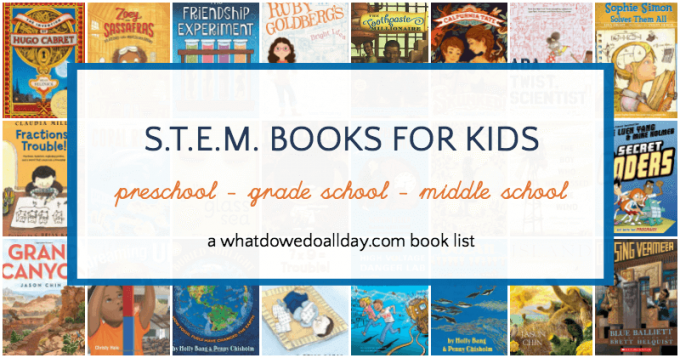
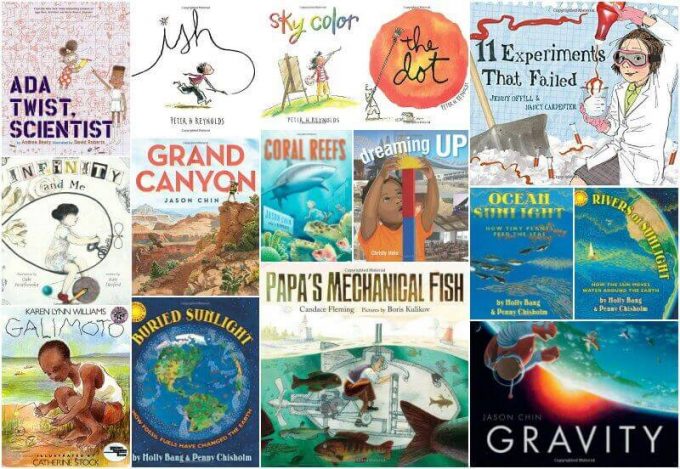
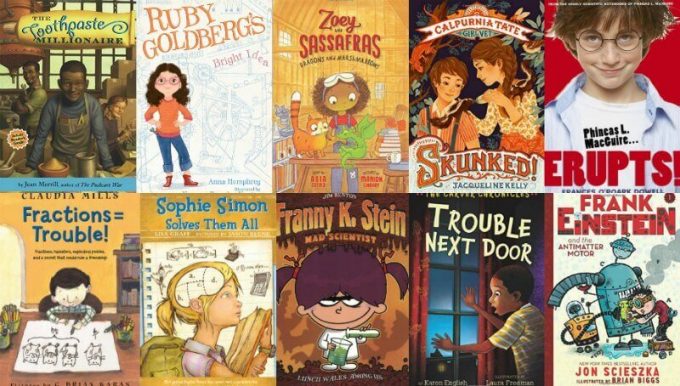

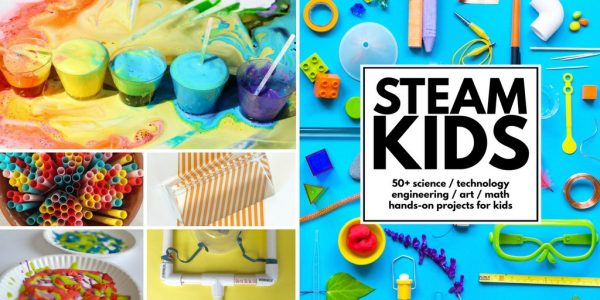
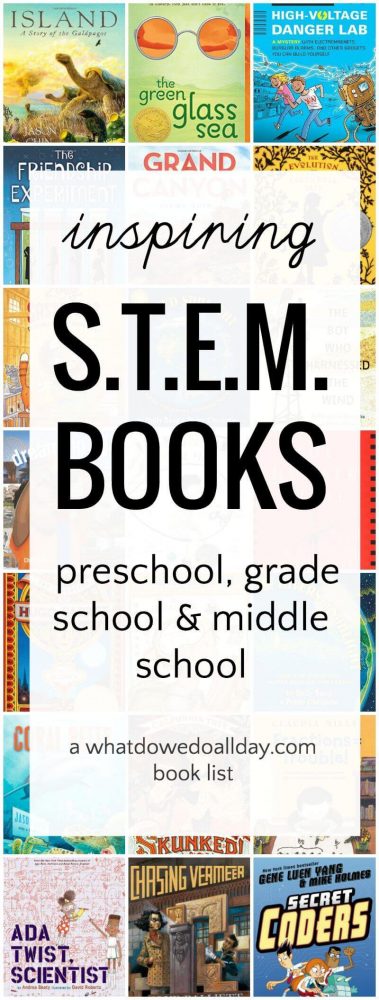

Jennifer says
STEM Coloring and Activity Fun Book by J.D.Wright
Amazon.com and DanaClarkColors.com
Kerrine says
Great selection!
Just wanted to share a few more:
My Mummy is an Engineer (ISBN-13: 978-0993276903)
My Mummy is a Plumber (ISBN-13: 978-0993276927)
My Mummy is a Scientist (ISBN-13: 978-0993276941)
http://www.ButterflyBooks.uk
Lois Melbourne says
May I also suggest "STEM Club Goes Exploring" designed to explore careers in STEM.
Erica says
Thank you for the recommendation.
Kristin says
Thanks - we added a couple new ones to our reading list. We also love and recommend the Galaxy Zack series and the George's Secret Key to the Universe series!
Cathy says
I’d like to add “Emmet’s Storm” (winner Best STEM 2017) and the next in the series “Inga’s Amazing Ideas” both historical fiction with real science, for grades 5-8. Written by a retired science teacher.
Cathy says
"Inga's Amazing Ideas" was awarded Best STEM Book 2019 by NSTA and CBC.